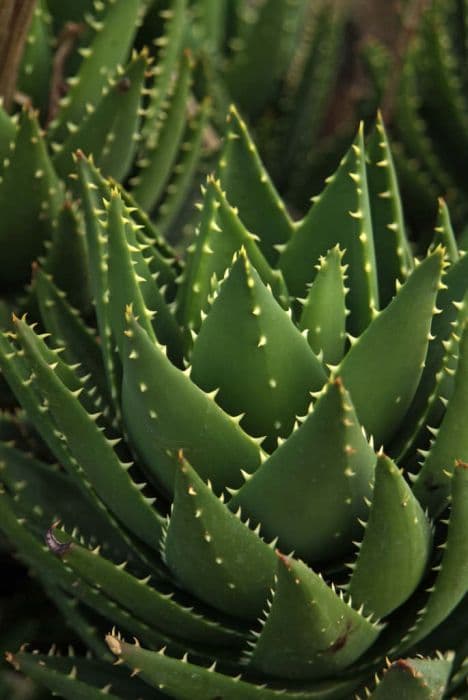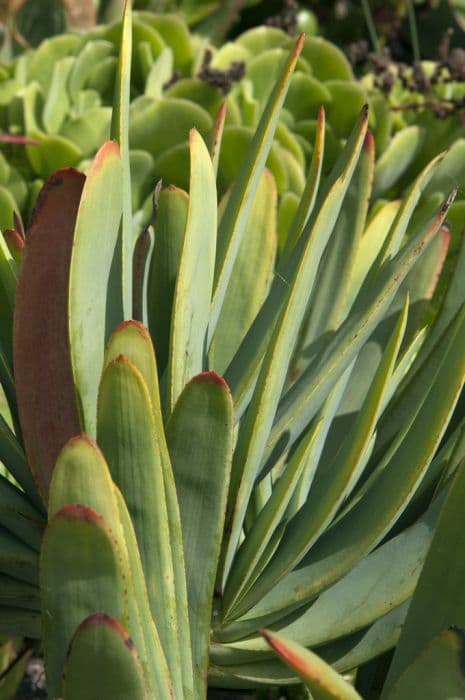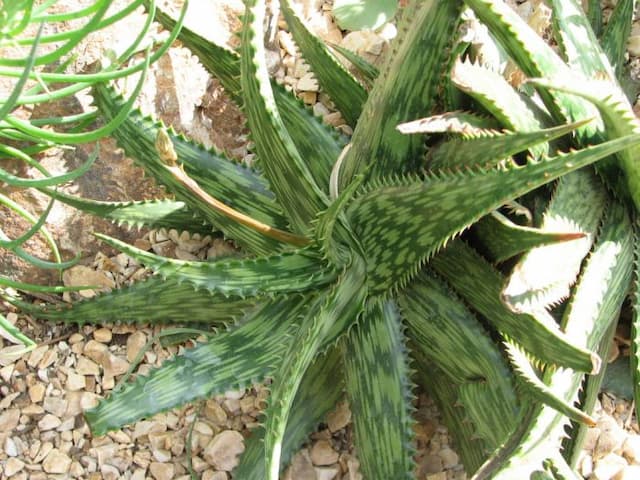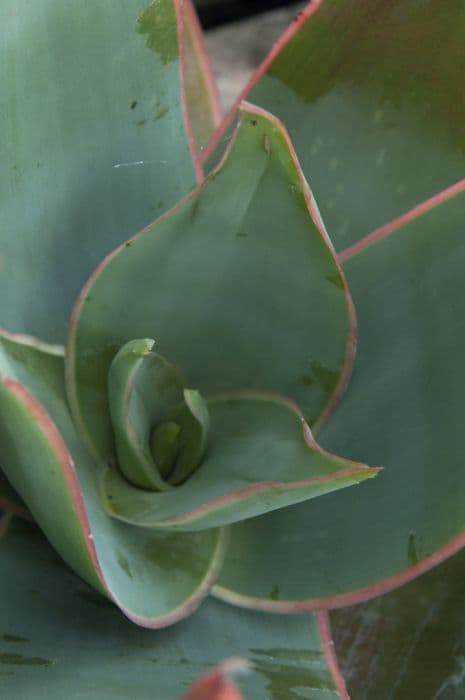Horse's teeth Haworthia truncata



ABOUT
Haworthia is a genus of miniature and dwarf succulent herbaceous plants of the Asphodelaceae family. It is a perennial evergreen succulent native to South Africa.
The plump leaves form a rosette up to 4 inches in diameter on a nearly non-existent stem. The different species of Haworthia differ mainly in the shape, color and texture of the leaves. Often the plants produce many lateral shoots, forming dense cushion-like peduncles.
Haworthia truncated has symmetrically arranged, as if cut leaves with a square section up to 2 inches long. The gray or gray-green leaves with white or gray lines grow almost vertically to the ground. Flowering occurs in spring and summer in a straight brush 8 inches tall consisting of small white flowers.
About this plant
 Names
NamesFamily
Asphodelaceae
Synonyms
Perdetande, Lithops, Maughanii, Truncate haworthia, Elephant Haworthia
Common names
Haworthia truncata var. maughanii, Haworthia truncata var. truncata
 Toxicity
ToxicityTo humans
There is no information available about the toxicity of Haworthia truncata to humans. It is always a good idea to be cautious when handling any plant, as some plants may cause irritation to the skin or produce an allergic reaction in some people. If you are concerned about the safety of Haworthia truncata, it is recommended to keep it out of reach of small children and pets, and to wash your hands after handling the plant.
To pets
It is generally considered safe for animals. However, it is always best to keep all plants out of reach of pets and children to prevent accidental ingestion.
 Characteristics
CharacteristicsLife cycle
Perennials
Foliage type
Evergreen
Color of leaves
Dusty green
Flower color
White
Height
Up to 4 inches
Spread
Up to 4 inches
Plant type
Succulents
Hardiness zones
9
Native area
South Africa
Benefits
 General Benefits
General BenefitsHaworthia truncata is a low-maintenance plant that is well-suited to growing indoors in a pot;
It is also non-toxic, making it safe to have around children and pets;
It can be used to purify the air inside your home and can add a decorative touch to your interior decor;
Some people also use it in feng shui practices or to symbolize certain things, such as protection or good fortune. Air-purifying Qualities
Air-purifying QualitiesHaworthia truncata is an air-purifying plant, meaning it can help remove toxins and pollutants from the air in your home.
It is especially effective at removing formaldehyde, which is a common indoor pollutant found in cleaning products, personal care products, and building materials. By helping to clean the air in your home, Haworthia truncata can improve the overall air quality and contribute to a healthier living environment.
Interesting Facts
 Feng Shui
Feng ShuiHaworthia truncata can be used in feng shui by placing the plant in the southeast area of a room or home, which is associated with the wood element and represents growth, abundance, and new beginnings. It is also said to be helpful in activating the wealth corner and attracting positive energy.
 Plant Symbolism
Plant SymbolismIn terms of symbolism, Haworthia truncata is often associated with endurance and perseverance due to its ability to survive in harsh, dry conditions. It is also considered a symbol of protection and stability. Some people believe that the plant brings good luck and prosperity to its owner.
 Water
WaterHaworthia truncata is a succulent plant, which means that it has thick, fleshy leaves that store water. As a result, it is important not to over-water the plant, as this can lead to root rot and other problems.
The best way to water Haworthia truncata is to allow the soil to dry out completely between waterings. This typically means watering the plant once a week or so, but this can vary depending on the humidity and temperature in your area. Light
LightIn general, Haworthia truncata prefers bright, indirect light ,and can tolerate some direct sun. It is best grown near a south- or east-facing window. It can also be grown outdoors in a bright, sheltered location, such as a patio or balcony. Just be sure to provide some shade during the hottest part of the day to prevent sunburn.
 Temperature
TemperatureHaworthia truncata prefers temperatures between 65-75 °F.
It can tolerate some variation in temperature, but it is important to protect the plant from extreme heat or cold. If the temperature drops below 50 °F, the plant may become stressed and may stop growing. Similarly, if the temperature rises above 90 °F, the plant may become sunburnt and may suffer from heat stress. Pruning
PruningOnly dead and iseased leaves need to be pruned.
 Cleaning
CleaningEvery few weeks
 Soil
SoilHaworthia truncata is a succulent plant that requires a well-draining soil mix. It is important to use a soil that allows excess water to drain away from the plant's roots, as standing water can lead to root rot and other problems.
In terms of pH, Haworthia truncata is relatively tolerant and can grow in soil with a wide range of pH levels. However, it generally prefers slightly acidic to neutral soil, with a pH between 6.0 and 7.0. Repotting
RepottingHaworthia truncata is a slow-growing plant that does not typically require frequent repotting. In fact, it is generally best to allow the plant to become slightly pot-bound before repotting, as this can help encourage healthy growth.
In general, it is a good idea to repot Haworthia truncata every 2-3 years or so, depending on the size of the plant and the size of the pot. Humidity & Misting
Humidity & MistingIn general, Haworthia truncata prefers humidity levels between 40-50%.
If the humidity in your home is lower than this, you can increase the humidity around the plant by placing a humidifier nearby or by misting the plant with water every few days. You can also place a tray of water near the plant and fill the tray with pebbles, which will help create a humid microclimate around the plant. Suitable locations
Suitable locationsIndoor
All year round
Outdoor
If you are growing Haworthia truncata outdoors, it is important to choose a location that receives plenty of bright, indirect light.
If you live in an area with freezing winter temperatures, it is generally best to bring Haworthia truncata indoors before the first frost to protect it from the cold. However, if you live in an area with mild winters, the plant may be able to tolerate some light frost and can be left outdoors year-round. Just be sure to provide the plant with some protection from extreme cold and to monitor the weather conditions to ensure that it stays within the optimal temperature range.Hardiness zone
10 - 11 USDA
 Life cycle
Life cycleHaworthia truncata is a hardy plant that can be planted at any time of year, as long as the weather conditions are suitable. In general, it is a good idea to plant Haworthia truncata in the spring or early summer, when the weather is warm and the soil is starting to warm up.
Haworthia truncata follows a pattern of growth and dormancy that is typical of many succulent plants. In the spring and summer, the plant is actively growing, producing new leaves and flowers. During this time, it is important to provide the plant with adequate moisture, light, and nutrients to support healthy growth.
In the fall and winter, the plant enters a dormant period, during which it slows down its growth and becomes less active. During this time, it is important to reduce watering and fertilization to allow the plant to rest and recharge. Propogation
PropogationPropogation time
Spring - summer
By OFFSETS:
Locate an offset on the plant. Offsets are small, plantlets that grow at the base of the main plant and are often attached to the mother plant by a short stem. Carefully cut the offset away from the mother plant using a clean, sharp knife or scissors. Be sure to cut as close to the base of the offset as possible to minimize damage to the plant.
Allow the cut surface of the offset to callus over for a few days before planting. This will help prevent rot and promote healthy growth.
Once the cut surface has callused over, plant the offset in a small pot filled with a well-draining soil mix. Water the soil lightly and place the pot in a bright, indirect light location.
Keep the soil moist but not soggy, and be sure to water the plant sparingly to avoid overwatering. Within a few weeks, the offset should start to grow roots and new leaves, indicating that it has successfully propagated.
By LEAF CUTTINGS:
Choose a healthy, undamaged leaf from the plant.
Cut the leaf away from the plant using a clean, sharp knife or scissors. Be sure to cut as close to the base of the leaf as possible to minimize damage to the plant.
Allow the cut surface of the leaf to callus over for a few days before planting. This will help prevent rot and promote healthy growth.
Once the cut surface has callused over, place the leaf on top of a well-draining soil mix in a small pot. Water the soil lightly and place the pot in a bright, indirect light location.
Keep the soil moist but not soggy, and be sure to water the plant sparingly to avoid overwatering. Within a few weeks, the leaf should start to produce new plantlets, indicating that it has successfully propagated.
 Pests
PestsSpider mite, Mealybug, Aphid
 Diseases
DiseasesGrey mold, Root Rot, Powdery mildew









